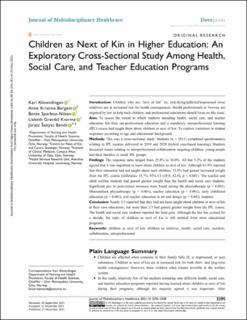| dc.contributor.author | Almendingen, Kari | |
| dc.contributor.author | Bergem, Anne Kristine | |
| dc.contributor.author | Sparboe-Nilsen, Bente | |
| dc.contributor.author | Kvarme, Lisbeth Gravdal | |
| dc.contributor.author | Saltyte Benth, Jurate | |
| dc.date.accessioned | 2022-01-21T14:58:11Z | |
| dc.date.available | 2022-01-21T14:58:11Z | |
| dc.date.created | 2021-11-18T11:45:20Z | |
| dc.date.issued | 2021-11-27 | |
| dc.identifier.citation | Journal of Multidisciplinary Healthcare. 2021, 14 3295-3308. | en_US |
| dc.identifier.issn | 1178-2390 | |
| dc.identifier.uri | https://hdl.handle.net/11250/2838773 | |
| dc.description.abstract | Introduction: Children who are “next of kin” (ie, sick/dying/addicted/imprisoned close relatives) are at increased risk for health consequences. Health professionals in Norway are required by law to help such children, and professional educations should focus on this issue.
Aim: To assess the extent to which students attending health, social care, and teacher education felt their uni-professional education and a mandatory interprofessional learning (IPL) course had taught them about children as next of kin. To explore variations in student responses according to age and educational background.
Methods: This was a cross-sectional study. Students (n = 2811) completed questionnaires relating to IPL courses delivered in 2019 and 2020 (hybrid case-based learning). Students discussed issues relating to interprofessional collaboration targeting children, young people and their families in small IPL groups.
Findings: The response rates ranged from 25.8% to 36.0%. All but 5.2% of the students agreed that it was important to learn about children as next of kin. Although 61.9% reported that their education had not taught about such children, 73.8% had gained increased insight from the IPL course (difference 35.7% 95% CI (29.0; 42.0), p < 0.001). The teacher and child welfare students had gained greater insight than the health and social care students. Significant pre- to post-course increases were found among the physiotherapy (p < 0.001), Mensendieck physiotherapy (p < 0.001), teacher education (p < 0.001), early childhood education (p < 0.001), and teacher education in art and design (p = 0.042) students.
Conclusion: Nearly 2/3 reported that they had not been taught about children as next of kin at their own educations, but more than 2/3 had gained greater insight from the IPL course. The health and social care students reported the least gain. Although the law has existed for a decade, the topic of children as next of kin is still omitted from most educational programs. | en_US |
| dc.language.iso | eng | en_US |
| dc.publisher | Dove Medical Press | en_US |
| dc.relation.ispartofseries | Journal of Multidisciplinary Healthcare;Volume 2021:14 | |
| dc.rights | Navngivelse-Ikkekommersiell 4.0 Internasjonal | * |
| dc.rights.uri | http://creativecommons.org/licenses/by-nc/4.0/deed.no | * |
| dc.subject | Next of kin-children | en_US |
| dc.subject | Relatives | en_US |
| dc.subject | Children | en_US |
| dc.subject | Health | en_US |
| dc.subject | Social care | en_US |
| dc.subject | Teachers | en_US |
| dc.subject | Interprofessional collaboration | en_US |
| dc.title | Children as Next of Kin in Higher Education: An Exploratory Cross-Sectional Study Among Health, Social Care, and Teacher Education Programs | en_US |
| dc.type | Peer reviewed | en_US |
| dc.type | Journal article | en_US |
| dc.description.version | publishedVersion | en_US |
| dc.rights.holder | © 2021 Almendingen et al. | en_US |
| cristin.ispublished | true | |
| cristin.fulltext | original | |
| cristin.fulltext | original | |
| cristin.qualitycode | 1 | |
| dc.identifier.doi | https://doi.org/10.2147/JMDH.S338686 | |
| dc.identifier.cristin | 1955901 | |
| dc.source.journal | Journal of Multidisciplinary Healthcare | en_US |
| dc.source.volume | 14 | en_US |
| dc.source.pagenumber | 3295-3308 | en_US |

